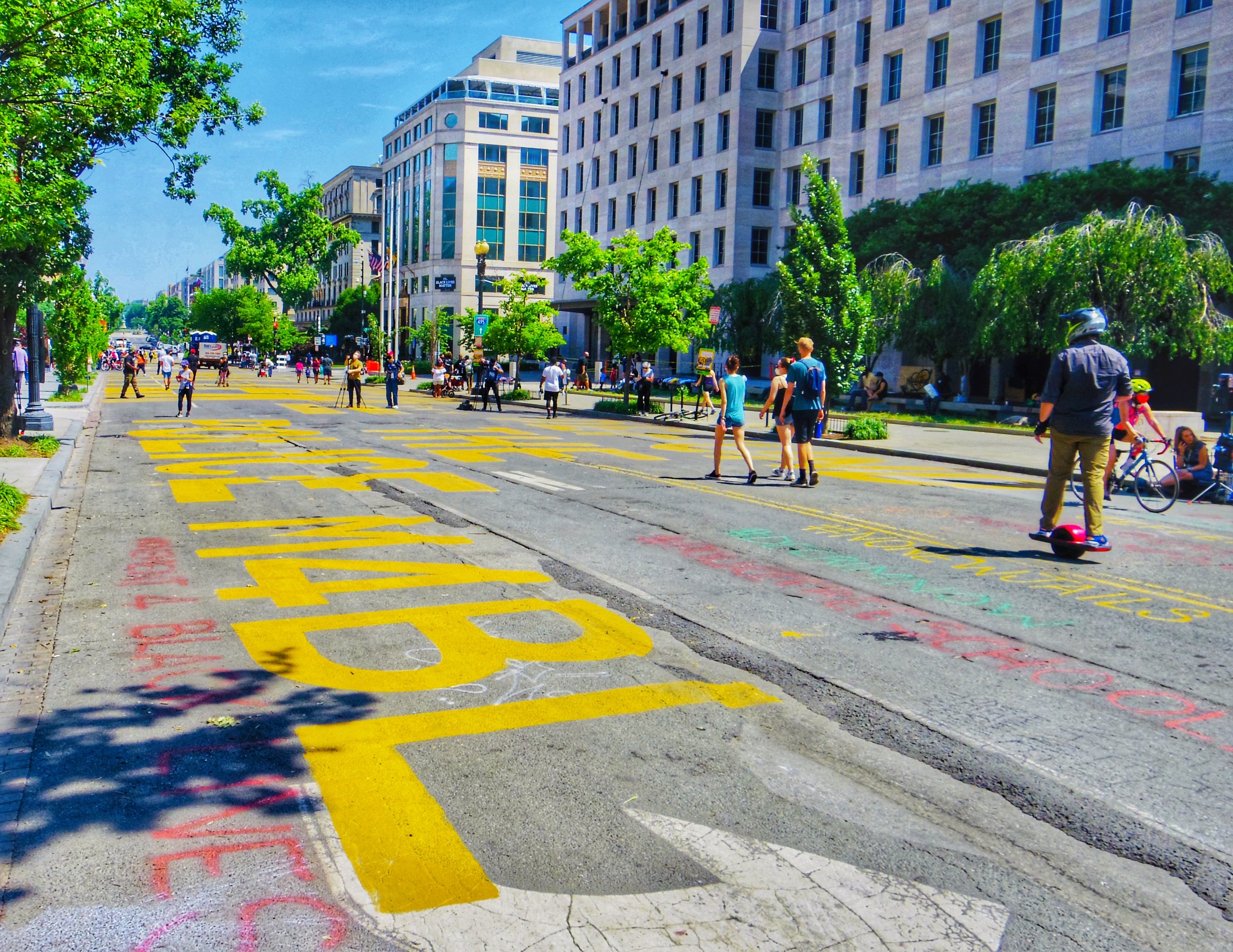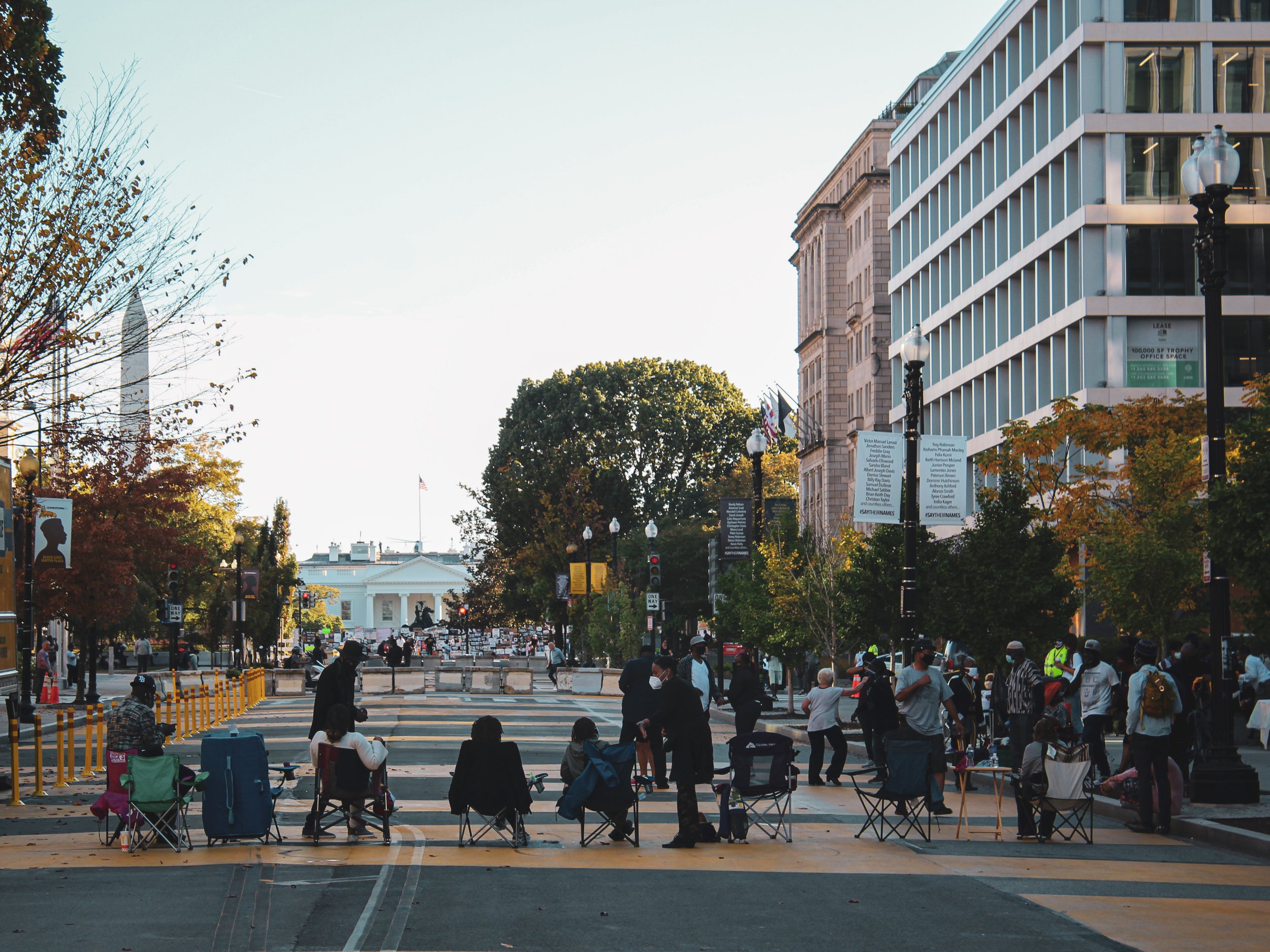160 years ago, the direction of these United States changed in an instant, right at this spot.
Five days after the confederate general Robert E. Lee surrendered to Union forces in a Virginia courthouse, President Lincoln was shot at Ford's Theatre during an assassination attempt by the actor John Wilkes Booth. The date was April 14, 1865.
Booth succeeded, and Lincoln died within hours inside a house across from the Theatre on 10th Street NW.
Lincoln had just been sworn in for a second presidential term on March 4th, meaning his second term lasted less than six weeks.
The war was essentially over, but the last confederate ship didn't surrender until November 6th of that year.
And President Andrew Johnson later proclaimed the insurrection to be officially over on August 20, 1866.
Ford's Theatre did survive -- through many ups & downs, financial challenges, rebuilds, and renovations.
Today it still operates as a theatre, running about 4 shows per year. It's also an historical site of course; and acts as a living memorial to the slain President, Abraham Lincoln.
Then and Now: Dart Drug
Dart Drug and Vienna Hat Co. 11th Street NW at G Street. c. 1980
Compass Coffee. 11th Street NW at G Street. 2025.
Then and Now: Dart Drug at the corner on 11th and G Streets NW.
Dart Drug was a short-lived chain, first opened in DC in 1954. By the 1990s the company had dissolved, but not after pioneering the “superstore” format, growing from a simple pharmacy to a find-anything type retail format similar to a modern day Walgreens, CVS, or Duane Reade. Basically the owners sold whatever they could get a steep discount on while wholesale buying.
The Dart corporation also grew to encompass many other retail formats such as auto part stores and book stores.
In the early years Dart shook up the pharmaceutical industry by selling drugs below the wholesale price, forcing the large drug companies to adapt and change the way they market and sell drugs to distributor pharmacies.
The flame shone too bright however. Economic turmoil within the company and internal strife within the family that owned Dart led to its downfall as a corporation in the 1990s.
Today this former location of Dart Drug is inhabited by a coffee shop.
The Future of Telling Stories Part I: Museums
Lillian Evanti by Loïs Mailou Jones
In what can only be described as blitz, the White House and President Trump, as of today --April 3, 2025-- has issued 109 executive orders.
We're just 74 days into the term and the administration has issued more executive orders than any other in their first 100 days, already surpassing Franklin Roosevelt, who issued 99. The first Trump administration (2017-2021) itself issued just 33 executive orders in its first 100 days. Biden issued 43, Obama 19, W. Bush 11, and Clinton 13.
First of all, what is an executive order? I found this explanation by the ACLU helpful. (linked)
An executive order is a written directive, signed by the president, that orders the government to take specific actions to ensure “the laws be faithfully executed.” It might mean telling the Department of Education to implement a certain rule, or declaring a new policy priority. Executive orders, however, cannot override federal laws and statutes.
...
With an executive order, the president can’t write a new statute, but an order can tell federal agencies how to implement a statute.
...
With an executive order, President Trump can order the federal government to take any steps that are within the scope of the constitutional authority of the executive branch, and do not violate any federal law.
For perspective, I am not lawyer. I am an historian that relays histories through walking tours and storytelling. I have also been a civics educator, museum educator, and a professional development expert for teachers. Across several disciplines, I have two decades of experience in the education field. But, you don't have to be a lawyer or an educator to understand the practical, on-the-ground consequences of an executive order.
One of the recently issued orders was "Restoring Truth and Sanity to American History," issued on March 27th. The order chastises two museums in particular, the National Museum of African American History and Culture and the American Women's History Museum.
In the order, the Smithsonian is cautioned (by way of conditioning federal expenditures) against creating programs that:
"...degrade shared American values, divide Americans based on race, or promote programs or ideologies inconsistent with Federal law and policy; and
... recognize men as women in any respect in the Museum."
In essence, this order seeks to control narratives of American history & culture developed by Smithsonian museums through exhibitors and other programming. Federal policy has revealed itself in the past few months as essentially opposing mentions or acknowledgment of any struggle against racism, sexism, transphobia, xenophobia, and other institutional challenges faced by marginalized people.
Which leaves me wondering what exactly Smithsonian museums will be allowed to showcase within their walls. Of course, not all museums feature historical exhibitions. Visual arts, music, design, textiles, crafts, math, science, aviation, geography, history, culture, and even the humble postage stamp are covered in some part by Smithsonian museum exhibitions. And yes, the National Zoo is included.
Would these past exhibitions be allowed under what are sure to be newly introduced guidelines?
Righting a Wrong, NMAH. Closed in 2019. A very small (maybe 1,000 square foot) exhibition exploring the effects of Executive Order 9066 on Japanese Americans during World War II. About 120,000 people of Japanese descent were imprisoned against their will and without due process by President Roosevelt's Executive Order. Is presenting this information divisive? What about nomenclature and terminology -- Would the camps be referred to "assembly centers," internment camps, concentration camps, works camps, or prisons? Would this exhibition be allowed at all? This exhibition, like many successful exhibitions, features stories told by real people themselves or through objects from their lives.
We Belong Here, NMAH. This is a current exhibition (unveiled in 2022) in the common area on the first floor. It features stories of athletes that exemplify the changes made possible by Title IX, a landmark law that bolstered equality in sports. Some of the original text of the exhibition read "...athletes continue to face sexism, racism, transphobia, and other forms of bigotry." Would that statement be allowed under the new executive order? Currently, the exhibition features Leo Baker, a trans, non-binary skateboarder. Would their story be scrubbed? Will exhibitions be allowed to acknowledge both the progress made AND lingering disparities, as this exhibition does? This exhibition, like many successful exhibitions, features stories told by real people themselves or through objects from their lives.
Americans, NMAI. This is also a current, but long running exhibition. Americans may be my favorite permanent exhibition of the National Mall museums. Filled with artifacts, this exhibition explores the full extent that American Indian imagery has been embedded in American life -- from the seemingly benign to the extremely problematic and hurtful. And it's deep. Many "traditional" narratives about Americana are challenged, including deeply embedded historical narratives about the Thanksgiving holiday and misinterpreted historical narratives about Pocahontas & other real life figures. Will these illuminations be removed? Will visitors be allowed to receive this information and be prompted to think about reasoning and implications? This exhibition, like many successful exhibitions, features stories told by real people themselves or through objects from their lives.
To be clear, none of these specific exhibitions have been slated for removal, adaptation, or any other changes as of today. But my fear is that either 1) vague, prohibitive, and punitive guardrails are placed on museum leadership and staff, or 2) line-item, word-for-word changes are made in specific exhibitions by non-museum government overseers, or 3) both. Either would lead to a diminished and tarnished role for these museums as centers of learning. This would be a disservice to U.S. Americans and non-American visitors alike.
Where would that leave the museum landscape? Storytelling comes in many forms. When helping the average visitor to Washington, DC start to understand the deep and complex woven fabric of U.S. history and culture, the Smithsonian is the first place most people start. The artifacts within the museums are not static pieces of history. The text, photos, websites, and programming that accompany the objects bring the objects to life.
It's not perfect, and any one museum wouldn’t be able to paint every picture from every possible perspective. However, across 19 museums (and hopefully more) this institution, along with other non-Smithsonian museums, are the most accessible way to see the vast narratives that make us, us. Disrupting this pathway to leaning for narrow political and punitive reasons would harm the work museums have been doing to be more representative and could destroy public trust that those efforts will continue.
In Part II, I'll dive into what this executive order could mean for me as a researcher, guide, and educator. I use narratives to pass along information to visitors who are with me for just a short amount of time, but want to learn a lot of DC and American history. Will that change? And how will our relationships with museums change if many are forced into editing history for unjust reasons?
Links:
Official White House page "Restoring Truth..." EO
Akin (law firm) summary of "Restoring Truth..." EO
Federal Register (Archives) list or 2025 EOs
UCSB American Presidency Project EO Tracker
Black Lives Matter Plaza: 2020-2025
News crews and onlookers gather as city employees begin to dismantle Black Lives Matter Plaza.
Two weeks ago, I gave what was I thought could possibly my last tour ever at Black Lives Matter Plaza. A group of college students from Pennsylvania wanted to see the plaza before its potential removal, which they had read about in the news before their DC trip. At the time, that meant the plaza could cease to exist as early as the next day, which was Monday, March 10.
Indeed on the morning of March 10, Black Lives Matter Plaza was cordoned off and workers began the process of deconstructing the mural and roadway. Even the Black Lives Matter street signage came down.
It was a stunning development that came together in less than one calendar week, undoing a five year statement piece of art that also happened to be a part of the built environment.
The mural was created by the city in 2020 and updated to a more semi permanent footprint in 2021.
The original mural was commissioned by Washington, DC Mayor Muriel Bowser in June of 2020. After nationwide protests over police brutality reached DC, protesters were met with aggressive and violent pushback from the state (local police and federal forces). The most egregious and violent clashes took place near the White House in the area of 16th Street NW and Lafayette Square. The mayor commissioned the mural on June 5, 2020 and instructed the Department of Public Words to paint the words "Black Lives Matter" in huge 35 foot tall letters over the 800 and 900 blocks of 16th Street NW. Those two blocks had already been temporarily closed to auto mobile traffic since major protests broke out in DC.
The next spring, in May of 2021, the mural was altered to make it semi-permanent, as the roadway was transformed to create a pedestrian walkway in the center, leaving just two lanes for motor vehicles --one in each direction. In addition, stonework and decorative bricks were added to the roadway to frame the newly repainted words "Black Lives Matter Plaza."
Over the years, I would occasionally get a requests to visit the two block stretch, all the way up to the last group of college students from Pennsylvania.
For years, local leaders in DC have feared the intrusion of the federal government into DC affairs. As a reminder, the District of Columbia is a federal territory and DC's limited "Home Rule" is just 50 years old and enabled by Congress.
In March 2025 a Congressional Representative from Georgia introduced a bill that threatened to withhold some federal funding from DC if city leadership did not change the name of Black Lives Matter Plaza to "Liberty Plaza," remove the mural physically, and remove all references to Black Lives Matter Plaza in official documents.
The Mayor caved surprisingly quickly; indicating that the city would comply with, what was then, just a suggestion.
The next Monday, just hours after my final tour there, city workers began dismantling Black Lives Matter Plaza -- 3 months short of its 5th birthday.
Original iteration of Black Lives Matter Plaza, June 2020.
Gathering at Black Lives Matter Plaza October 2020.
Street signage for Black Lives Matter Plaza, November 2020.
A Minor Landmark
Strolling through Adams Morgan you can see the neighborhood has many disparate forms regarding the built environment. A big part of its identity is commercial -- restaurants, bars, and retail, mostly along 18th Street NW south of Columbia Road. The eastern part of Columbia Road itself is known for staple service businesses such as pharmacies, groceries, urgent care, a few banks, and even a veterinarian. Columbia Road west and Kalorama Road are known for their large, impressive multi-unit residential buildings that lead right into Dupont Circle.
Along Calvert Road, a homey vista of attached row houses line the curved thoroughfare all the way up to the Duke Ellington Bridge. When I first moved to DC I was living in nearby Mount Pleasant. This stretch of Calvert Street (1800 & 1900 blocks) was mostly known to me and my friends as group houses and party houses.
1929 Calvert Street NW (the white house)
To that extent, it makes a lot of sense that it was one of these houses hosted the first ever show for Minor Threat, one of DC's and punk music's seminal bands.
In December 1980, the newly formed band Minor Threat opened for another legendary DC band, Bad Brains, in the basement of 1929 Calvert St NW in Adams Morgan. The Minor Threat kids weren't complete unknowns as two of the members had already played in the popular Teen Idles, which broke up earlier that year. And they were kids -- Teen Idles was formed from a group of students enrolled in nearby Wilson High School.
Photo © Susie Josephson Horgan. Minor Threat early show.
Minor Threat continued an on-again off-again existence until permanently disbanding in the summer of 1983. Along the way songs like "Straight Edge" and EP's like "Out of Step" connected with DC punk kids and even more outside of the capital city. With the band members going on to be a part of even longer lived bands such as Fugazi, Bad Religion, Dag Nasty, and many others, the importance and influence of Minor Threat has been amplified over the decades.
Today the Calvert Street house is just... a house. No fanfare, no signage, just another row house in Adams Morgan. But the house will be part of a private tour I am writing for a client this spring. If all goes well, I may consider a permanent Adams Morgan tour based on music and social activism! It's a strong possibility.





















